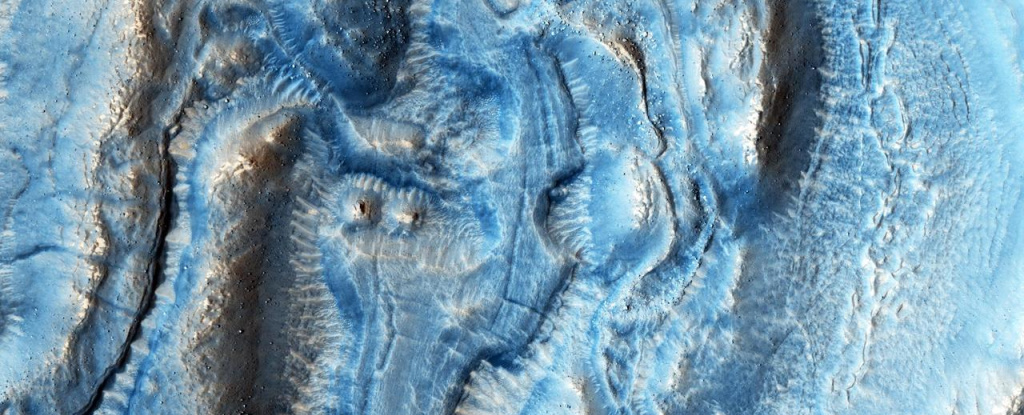On Earth, changes in our climate have caused glaciers to advance and recede throughout our geological history (known as ice ages and interglacial periods).
The movement of these glaciers has carved features on the surface including U-shaped valleys, hanging valleys, and fjords. These features are absent on Mars, leading scientists to conclude that all glaciers on its surface were stationary in the distant past.
However, new research from a team of US and French planetary scientists suggests that Martian glaciers moved more slowly than those on Earth.
The research was conducted by a team of geologists and planetary scientists from Arizona State University’s (ASU) School of Earth and Space Exploration (SESE) and Nantes Université’s Laboratorie du Planétologie et Géosciences (LPG) in France.
The study was led by Anna Grau Galofre, a 2018 Exploration Fellow at SESE (currently at LPG), who was a postdoctoral fellow at ASU at the time it was conducted.
The study, entitled Valley Networks and the Record of Glaciation on Ancient Mars, recently appeared in the Geophysical Research Letters.
According to the USGS definition, a glacier is “a large, perpetual accumulation of crystalline ice, snow, rock, sediment, and often liquid water, formed on land and moving downslope under the influence of its own weight and gravity.”
The key word here is movements created as meltwater collects beneath the ice sheet and smears its way down through the landscape. On Earth, glaciers have advanced and regularly retreated for eons, leaving behind boulders and debris and carving features into the surface.
For their study, Grau Galofre and her colleagues modeled how Mars’ gravity would affect the feedback between the velocity of an ice sheet and the flow of water beneath it. Faster water drainage would increase friction between rock and ice, leaving channels beneath the ice that would likely persist over time.
The absence of these U-shaped valleys means that ice sheets on Mars were likely moving and eroding the ground beneath them at an extremely slow rate compared to what occurs on Earth.
However, scientists have found other geological evidence that suggests there may have been glacial activity on Mars in the past. These include long, narrow, winding ridges of layered sand and gravel (esker) and other features that may be the result of subglacial channels.
Said Grau Galofre in a recent press release from AGUNews:
“Ice is incredibly nonlinear. The feedbacks related to glacial movement, glacial runoff, and glacial erosion would result in fundamentally different landscapes related to the presence of water beneath former ice sheets on Earth and Mars.
While on Earth you would get drumlins, lines, striations and moraines, on Mars you would tend to get channels and esker ridges under an ice sheet with exactly the same characteristics.”
To determine whether Mars has experienced glacial activity in the past, Grau Galofre and her colleagues modeled the dynamics of two ice sheets on Earth and Mars that shared the same thickness, temperature, and subglacial water availability.
They then adapted the physical framework and ice flow dynamics, which describe the outflow of water beneath Earth’s strata, to Martian conditions.
From this, they learned how subglacial drainage would develop on Mars, what effect it would have on the speed at which glaciers slide across the landscape, and what erosion it would cause.
These results show how glacial ice on Mars would drain away meltwater much more efficiently than glaciers on Earth. This would largely prevent lubrication at the base of the ice sheets, leading to faster slip rates and increased glacial-driven erosion.
In short, their study showed that lined landforms on Earth associated with glacial activity would not have had time to evolve on Mars.
Said Gray Galofre:
“From an early Mars with the presence of liquid surface water, extensive ice sheets, and volcanism to the global cryosphere that Mars currently is, the interaction between ice masses and basal water must have occurred at some point.
It is just very difficult to believe that in the 4 billion years of planetary history Mars never developed the conditions to grow ice sheets with subglacial water, given that it is a planet with extensive water resources, great topographical variations, the presence of both liquid and frozen water, volcanism, [and is] farther from the sun than the earth.”
In addition to explaining why Mars lacks certain glacial features, the work also has implications for the possibility of life on Mars and whether that life could survive the transition to a global cryosphere like the one we see today.
According to the authors, an ice sheet could provide a steady water supply, protection, and stability to all subglacial water bodies where life may have originated. They would also protect against solar and cosmic rays (in the absence of a magnetic field) and insulate against extremes in temperature.
These results are part of a growing body of evidence that life existed on Mars and survived long enough to leave evidence of its existence.
It also shows that missions like Curiosity and Perseverance, which will be joined in the near future by ESA’s Rosalind Franklin rover and other research robots, are looking in the right places.
Where water once flowed in the presence of slowly retreating glaciers, microbial life forms that arose when Mars was warm and wet (about 4 billion years ago) may have survived as the planet became colder and drier.
These results may also support speculation that as this transition progressed and much of Mars’ surface water retreated underground, potential surface life followed.
Therefore, future missions studying the extensive deposits of aqueous minerals on Mars (recently mapped by ESA) could be the ones that finally find evidence of life on Mars today!
This article was originally published by Universe Today. Read the original article.
#Ancient #glaciers #Mars #flowed #slowly #flowed


Leave a Comment